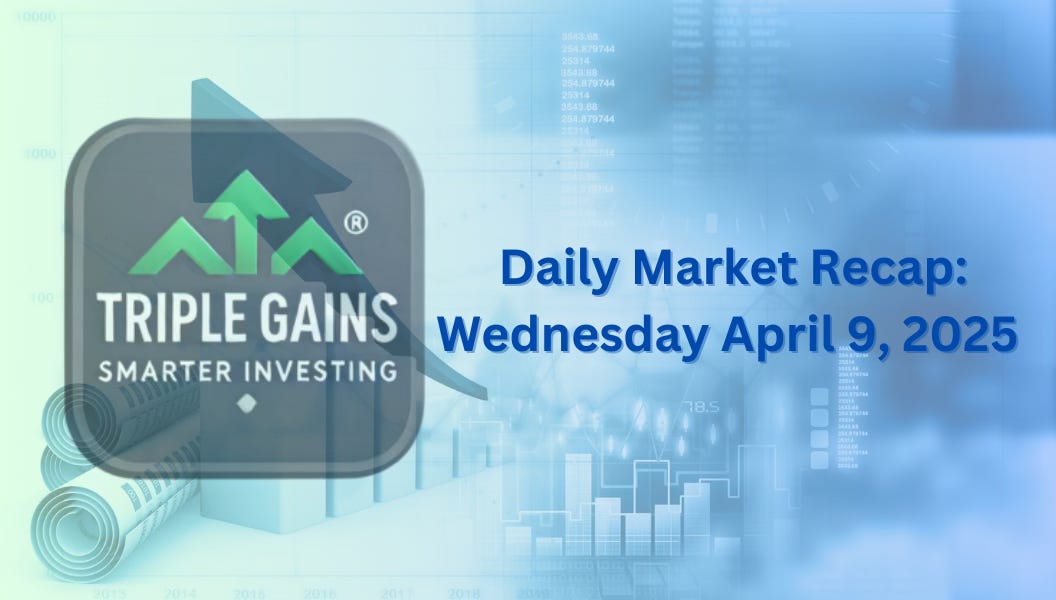Market Recap – Wednesday, April 9, 2025
A Sharp Rebound Amid Tariff Pause
US equities posted a significant rally today, with the S&P 500 jumping 9.5%, the Nasdaq climbing 12.2%, and the Russell 2000 up 8.7%. This marked the best day for the S&P 500 since October 2008 and the second-best session for the Nasdaq on record. The rally was largely driven by a major announcement from the Trump administration, which decided to pause higher reciprocal tariffs for 90 countries, while escalating tariffs on China to 125%, effective immediately. The VIX dropped back below 35, after earlier spiking to 57, signaling the market's relief from heightened volatility.
Sector Performances: Volatile Movements in Key Stocks and Sectors
Today's gains were led by the technology sector, especially the "Mag 7" stocks, with Apple (AAPL), Nvidia (NVDA), and Tesla (TSLA) among the top performers. The semiconductor sector (SOX) posted its best day on record. Airlines, cruise lines, apparel, autos, and credit cards also rallied strongly. In contrast, sectors like pharma, telecom, tobacco, and utilities lagged. Treasuries were under pressure, with the yield curve steepening as bond yields rose significantly, particularly on the shorter end.
Trade Policy Updates: A Mixed Bag of Tariff Negotiations
The Trump administration's decision to pause tariff increases for 90 countries, while increasing tariffs on China to 125%, drove much of today's market sentiment. The tariff suspension applies to countries that have refrained from retaliating and have expressed interest in negotiating a trade deal with the US. However, this tariff escalation with China has added more uncertainty to the trade landscape. The White House has emphasized the importance of negotiating with allies and partners while escalating pressure on China to reach a deal. China's response to this move has been to announce an increase in tariffs on US goods, adding to the tension. While a temporary reprieve for some countries is welcome, the overall trade policy uncertainty continues to weigh heavily on the markets.
Bond Market Dynamics: Rising Yields Amid Trade Tensions
The bond market has been under significant pressure, with 10-year yields briefly surpassing 4.5%, marking a 50 basis point increase this week. The sharp rise in bond yields has raised concerns about liquidity and the potential for further volatility in the credit markets. A weak auction of 3-year notes earlier in the week has added to concerns about the stability of the bond market. There's growing speculation that the Fed might need to intervene to stabilize the bond market, especially as trade tensions escalate. This has also raised questions about foreign investment in US treasuries, with the dollar's recent weakness adding fuel to the debate about the future of US debt.
Corporate Earnings and Guidance: Mixed Signals in Q1 Reports
While today saw strong performance in sectors like healthcare, with significant Medicare reimbursement increases expected for 2026, corporate earnings remain mixed. Delta Air Lines (DAL) posted better-than-expected Q1 earnings, but the company pulled its FY guidance due to the ongoing uncertainty. Walmart (WMT) reaffirmed its Q1 sales guidance and left its FY guidance unchanged, though it noted that the range of outcomes had widened due to tariff impacts. Other companies, such as Peabody Energy (BTU), have seen their stocks rise following announcements of strategic reviews, while Neogen (NEOG) saw a dramatic decline due to missed earnings and lowered guidance.
Here’s Our Take: Navigating the Trade Uncertainty
Today’s market rally provides a temporary respite, but the underlying uncertainty around trade policy and its economic impact remains. The decision to escalate tariffs on China and the ongoing trade negotiations with other countries introduce significant volatility, and the market's reaction today was heavily influenced by technical factors and oversold conditions. While certain sectors, such as technology and travel, may benefit from tariff pauses or reduced trade barriers, the broader risk remains with higher tariffs and their impact on inflation, corporate earnings, and global growth. Investors should remain cautious and focus on diversifying portfolios to weather continued market volatility. Additionally, with bond yields on the rise, interest rate expectations and the potential for Fed intervention are critical factors to monitor moving forward. Long-term investors should stay vigilant and watch for signs of a more stable trade environment before making significant portfolio adjustments.



